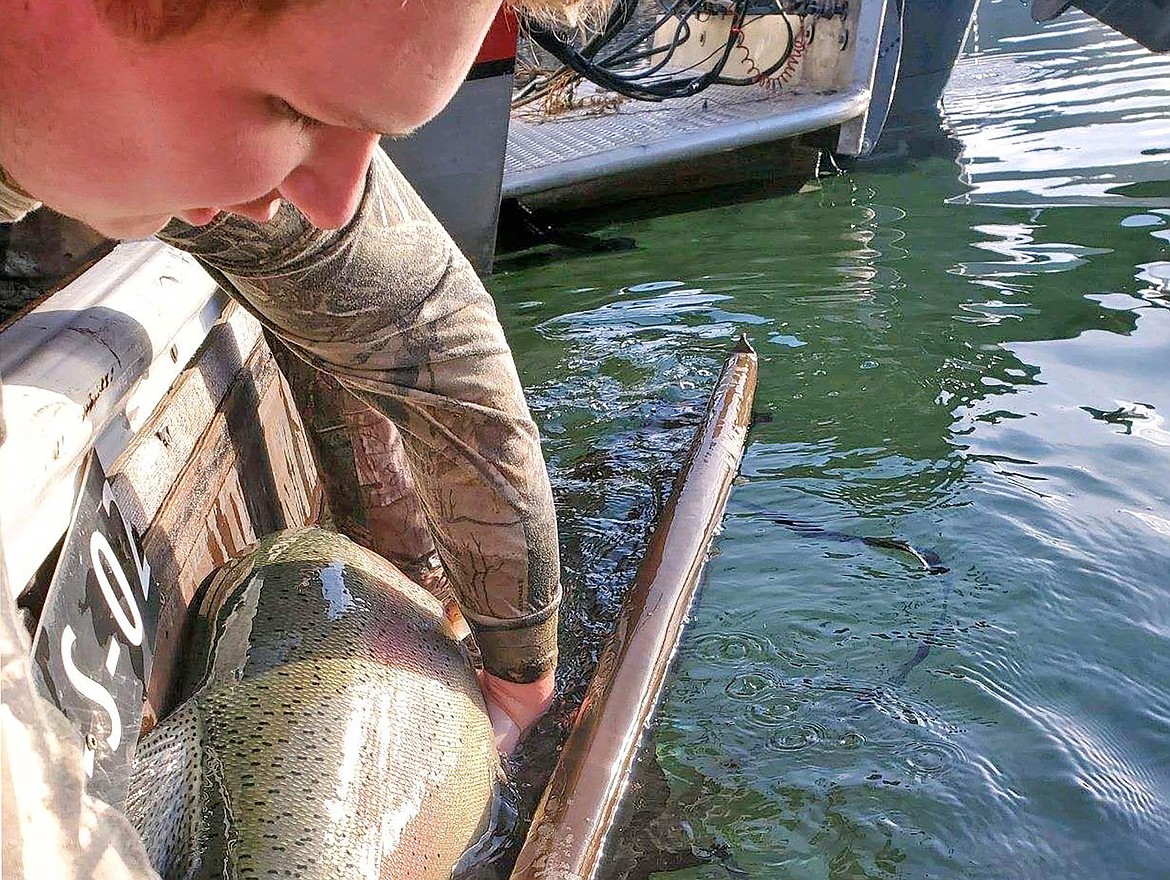IDFG: LPO fishery in good shape
KATHY HUBBARD Contributing Writer | Bonner County Daily Bee | UPDATED 4 years, 8 months AGO
▶️ Listen to this article now.
SANDPOINT — “I would argue that the trophy fishery, as a whole for all species combined right now, is as good as it’s ever been.”
That was the message from Andy Dux, regional fish manager at Idaho Fish and Game, during the first part of last week’s two-part state-of-the-lake address. This year’s report was held virtually, opening with a detailed, in-depth presentation about Lake Pend Oreille’s fishery followed by a subsequent question-and-answer session.
“It wasn’t that long ago that people called Lake Pend Oreille the ‘dead sea,’ ” Matt Corsi, IFG principal fishery research biologist said. “Fortunately, those days are gone.”
Both Corsi and Dux spoke to the recovery of the kokanee population, the main food source for predator fish, which were on the verge of collapse in the early 2000s, and how IDFG has partnered with anglers to suppress predators such as lake trout and walleye.
Most anglers who fish Lake Pend Oreille say that the jewel in the crown is the trophy rainbow trout population, something Dux spoke on in regards the growth of the fishery in the last few years.
The Lake Pend Oreille Idaho Club gives a patch for any fish over 25 pounds. Using that as a measure, from 1990 to 1994 close to 80 patches were given out. In the next 26 years, only nine were. However, in 2020, five patches were awarded, indicating the rejuvenation of the trophy fishery the success of which is on the backs of the kokanee.
There are several other species that make their home in Lake Pend Oreille. Bull trout and cutthroat are native species and since the bull trout is on the endangered species list, care is given to increase their already healthy population. There is a strong population of smallmouth bass and a lower density of yellow perch, brown trout and black crappie.
Walleye were illegally introduced into the lake, most likely because they were planted up the Clark Fork River in Montana. But, anglers often enjoy catching this sport fish. Many questions at the Q & A portion of IDFG’s presentation were focused on the walleye population which IDFG is working hard to keep suppressed because this predator fish is in competition with rainbow trout for food.
Northern pike are also illegal immigrants. Dux said that their numbers may be trending upwards and that Fish and Game is working to understand more about this species’ habits and diet but acknowledged that they can be a threat as well.
Suppression methods include angler incentive programs and gill netting. Corsi and Dux explained how these methods were employed, the cost and what their success levels were. By far, the cost of gill netting exceeds the dollars paid out for the angler incentive programs.
When asked why they wouldn’t consider relying on anglers, Corsi replied, “We use a two-prong approach to maximize success. Lake trout suppression wouldn’t be successful without the netting program. In terms of ROI (return on investment), the value to the fishery far outweighs the expense. We need both types of suppression to be effective.”
Another angler asked why IDFG doesn’t allow the sport fishery to evolve. “Why don’t you leave things alone? The lake suffers when you get involved.”
Dux said that there are thirteen species in the lake and that most of them can co-exist. But lake trout, walleye and northern pike threaten sustainability.
“For some time our focus has been on recovering the fishery” Dux said. “I think we’ve now transitioned into a new level to sustain the fishery which is now performing at a high level. Key is managing predation with a variety of predators in the lake. We have to find the balance between predator and prey to try to keep that balance so the fishery can continue to function at a high level.”
The future, for the most part, is to do more of the same. IDFG will continue to monitor the population of multiple species, they’ll continue with lake trout and walleye suppression with both the netting and angler incentive programs.
The tagging study, telemetry, growth rates and angler log projects will continue for rainbow trout. Diet and telemetry research will be conducted on walleye. IDFG will be tagging smallmouth bass, bull trout and cutthroat trout and, in the case of these native fish, survival studies will be held as well.
IDFG will continue the kokanee stocking program, manage improvement projects for tributary habitat, improve fishing and boating access and conduct an angler creel survey.
“The trophy fishery as a whole is exceptional right now and this isn’t just for the rainbow trout trophy fishery but also for other predators in the lake that reach large sizes. In fact, I would argue that the trophy fishery as a whole, for all species combined right now, is as good as it’s ever been,” Dux said.
In conclusion he said, “There’s a lot going on in the lake. It’s a complex fishery, there’s a lot of different elements to it. It’s certainly very difficult to keep everybody happy with all those interests but we’re doing the best we can to provide a fishery that’s functioning at a high level and providing a lot of diversity of opportunity. I think we’re having that occur right now and I hope that a lot of you are going to get out this year and participate in the fishery.”
For those interested in viewing these presentations, go to idfg.idaho.gov. IDFG is asking for public input regarding fishing regulations for the 2022-24 seasons and there is a link on their website for that as well.

